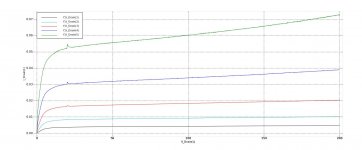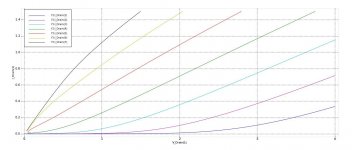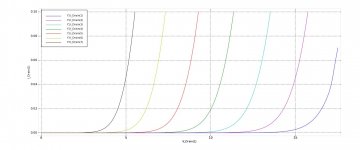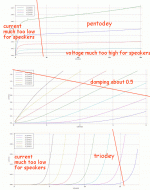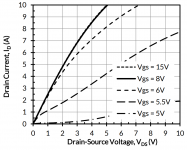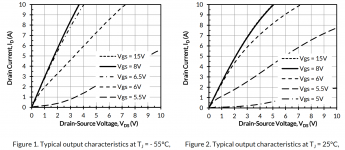I am opening a thread for the UJ3N065080K3S SiC JFET. Is there an operation area that has triode-like behavior?
This is a thread for curve tracer geeks.
I have attached the results of a curve tracer session of mine on this JFET.
In my experience, devices that have triode-like behavior, this behavior is at high-ish voltage and low-ish current. These same devices have pentode-ish behavior at high-ish current and low-ish voltage. I will post that behavior in the next post.
This is a thread for curve tracer geeks.
I have attached the results of a curve tracer session of mine on this JFET.
In my experience, devices that have triode-like behavior, this behavior is at high-ish voltage and low-ish current. These same devices have pentode-ish behavior at high-ish current and low-ish voltage. I will post that behavior in the next post.
Attachments
Here is the LU1014D. This family of curves show triode-ish behavior in the highest voltage portion of the plot with the most negative Vgs while the family of curves shows pentode-ish behavior at the highest current portion of the plot that has the most positive Vgs.
In this family of curves, Vgs spans from -1.2v to -0.4v.
In this family of curves, Vgs spans from -1.2v to -0.4v.
Attachments
My contention is that if a device has triode-ish behavior, you will see it at higher voltage and lower current. The lower current is helpful for limiting self-heating.
LU1014D does not seem to be in current production anymore.
Anyone know of anything similar? Except a triode ��
Anyone know of anything similar? Except a triode ��
LU1014D does not seem to be in current production anymore.
Anyone know of anything similar? Except a triode ��
Jims Audio on eBay has genuine LU1014D parts. He did send me 2 duds which he replaced when I alerted him to the problem.
2SK182ES are also available on eBay. I have bought and verified 2 pairs.
2SK60 / 2SJ18 I have bought from eBay and verified as genuine/good.
Russian KP926B I have bought from eBay and verified as genuine/good.
2SJ20 I have bought from eBay and verified as good.
Last edited:
I have about 8,000 on the shelf. They don't particularly need to be in production.

7.000
you obviously didn't check someone's handbag a year ago, nor shelves recently

...has triode-like behavior?....
Plot a reasonable load. For speakers, plot say 5A to 40V, which is 100W at 8 Ohms.
Are the device curves more vertical (lower Z) than this load?
While your last example is triodey compared to a speaker, I'd want to check the curves at speaker-like currents.
If you are bench-tracing, it may be useful to use a 40V supply and a 8 Ohm drain resistor, waggle the gate. (This IS how you will use it to drive a speaker, though you have a choice which leg is Common.)
Attachments
LU1014D does not seem to be in current production anymore.
Anyone know of anything similar? Except a triode ��
Plot a reasonable load. For speakers, plot say 5A to 40V, which is 100W at 8 Ohms.
Are the device curves more vertical (lower Z) than this load?
While your last example is triodey compared to a speaker, I'd want to check the curves at speaker-like currents.
If you are bench-tracing, it may be useful to use a 40V supply and a 8 Ohm drain resistor, waggle the gate. (This IS how you will use it to drive a speaker, though you have a choice which leg is Common.)
Good points. Thanks for the observations.
The point of the curves posted was just to separate the SIT-ish devices from non SIT-ish devices.
For the triode-y curves at low current at 15v, my interest is to use this operating point for a cascoded Zen V8 or V9-ish balanced amplifier to drive a set of Stax Gamma ESL headphones. From my research, 10mA bias may be enough. If 10mA is not enough, 100mA at 15v would be no problem.
I have about 8,000 on the shelf. They don't particularly need to be in production.

I think I have around 20, not quite as many as you.
Hahahaha
When really cold, it looks even better.. Maybe you could chill it with a Peltier cooler junction ;-p
Attachments
Last edited:
While it is performs more like a pentode than a triode, there is another application which I've tested where they work great: cascodes!
@1-2A they bias at around 8-10V if I remember my measurements correctly. In my testing at least it can handle 30W no problem so a plug in cascode for N channel devices with 24V up to 2A. Conveniently enough that where most single ended firstwatt amps run the devices at =)
@1-2A they bias at around 8-10V if I remember my measurements correctly. In my testing at least it can handle 30W no problem so a plug in cascode for N channel devices with 24V up to 2A. Conveniently enough that where most single ended firstwatt amps run the devices at =)
A 10V cascode means you lose 10V voltage headroom with the same supply voltage.
Or you have to raise it by 10V.
And it has a huge dependency on Vds.
And a high tempco.
Patrick
Or you have to raise it by 10V.
And it has a huge dependency on Vds.
And a high tempco.
Patrick
All Fets look a lot like Triodes at low Vds values, and cascoding is one way of
putting that to work, as the Vds can be set fairly arbitrarily.
The F3 did that by cascoding the LU1014 and setting the DC and AC Vds values
seen by the part. I recall that I was able to get some nice .00X% numbers that
way.

putting that to work, as the Vds can be set fairly arbitrarily.
The F3 did that by cascoding the LU1014 and setting the DC and AC Vds values
seen by the part. I recall that I was able to get some nice .00X% numbers that
way.

The IRFPS3810, IRL3103 and IRFP7430 should be curve traced.
They all seem to have quite a bit of triodity, but I don't know if any one has a triode like curves in a usable range of voltage and current.
They all seem to have quite a bit of triodity, but I don't know if any one has a triode like curves in a usable range of voltage and current.
All Fets look a lot like Triodes at low Vds values, and cascoding is one way of
putting that to work, as the Vds can be set fairly arbitrarily.
The F3 did that by cascoding the LU1014 and setting the DC and AC Vds values
seen by the part. I recall that I was able to get some nice .00X% numbers that
way.

Hats off to you for brilliant designs. Its electronic art that many people own and appreciate. I seriously enjoy studying your schematics.
The interesting thing to me about the LU1014D is that it seems to trace like the 2SK60 more than it does a standard JFET. And it is much less expensive to obtain than a 2SK60.
- Home
- Amplifiers
- Pass Labs
- United SiC UJ3N065080K3S, Is there any triode behavior?
